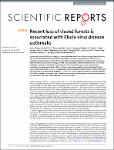Recent loss of closed forests is associated with Ebola virus disease outbreaks
Olivero, Jesús
Fa, John E.
Real, Raimundo
Márquez, Ana L.
Farfán, Miguel A.
Vargas, J. Mario
Gaveau, David
Salim, Mohammad A.
Park, Douglas
Suter, Jamison
King, Shona
Leendertz, Siv Aina
Sheil, Douglas
Nasi, Robert
Ebola virus disease (EVD) is a contagious, severe and often lethal form of hemorrhagic fever in humans. The association of EVD outbreaks with forest clearance has been suggested previously but many aspects remained uncharacterized. We used remote sensing techniques to investigate the association between deforestation in time and space, with EVD outbreaks in Central and West Africa. Favorability modeling, centered on 27 EVD outbreak sites and 280 comparable control sites, revealed that outbreaks located along the limits of the rainforest biome were significantly associated with forest losses within the previous 2 years. This association was strongest for closed forests (>83%), both intact and disturbed, of a range of tree heights (5–>19 m). Our results suggest that the increased probability of an EVD outbreak occurring in a site is linked to recent deforestation events, and that preventing the loss of forests could reduce the likelihood of future outbreaks.
Dateien zu dieser Publikation
Keine Lizenzangabe

